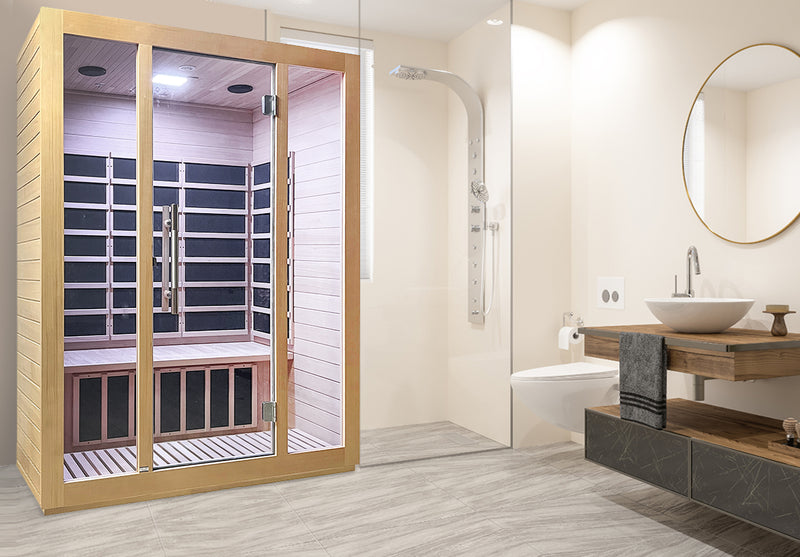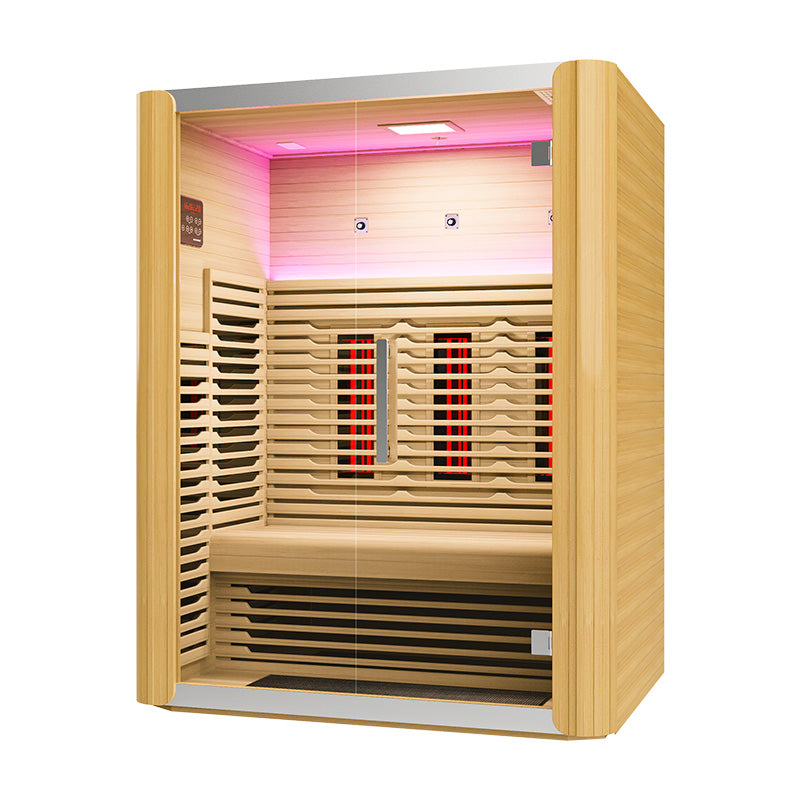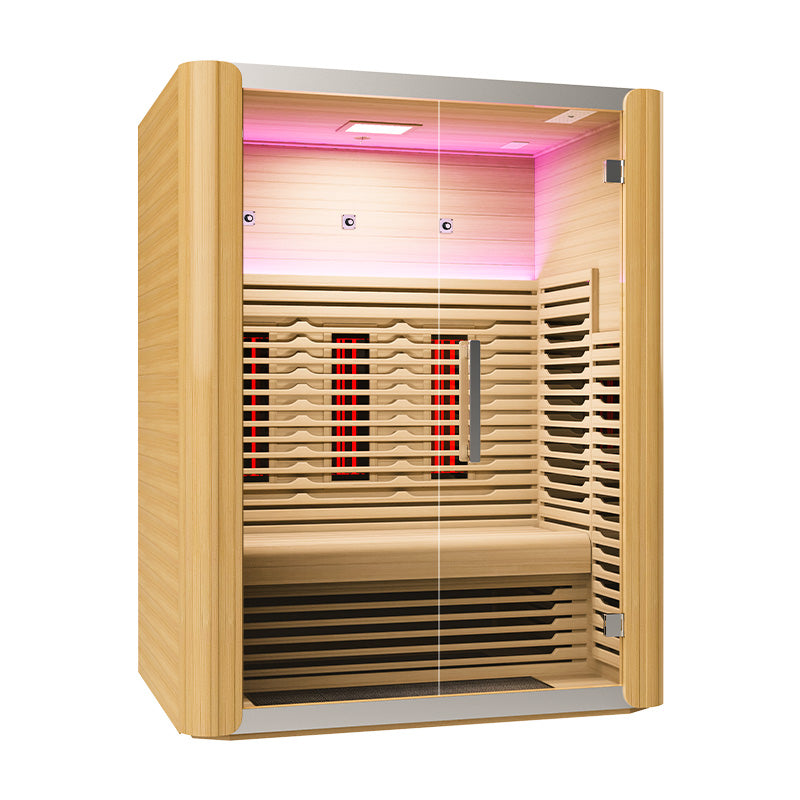Summary
Saunas offer remarkable health benefits, backed by extensive scientific research, including a reduction in cardiovascular disease risk by up to 50%, improvements in mental health, enhanced athletic performance, and support for immune function. Regular sauna use (three to four times weekly) has been linked to increased longevity, improved brain health, reduced inflammation, and enhanced quality of life. Studies from Finland, where sauna culture has thrived for thousands of years, show that frequent sauna users have significantly lower rates of heart disease, stroke, dementia, and all-cause mortality. Whether you opt for a traditional or infrared sauna, incorporating regular heat therapy into your wellness routine can offer profound benefits for both physical and mental well-being.
The Science of Sauna Therapy: How Heat Heals
Understanding Heat Shock Proteins
When you expose your body to the controlled stress of sauna heat, you trigger the production of heat shock proteins (HSPs). These remarkable molecules act as cellular guardians, protecting and repairing proteins throughout your body. Research from Stanford University shows that HSPs can:
- Prevent protein misfolding linked to neurodegenerative diseases
- Enhance cellular repair mechanisms
- Reduce inflammation at the molecular level
- Improve cellular resilience to future stressors
This cellular-level benefit translates to system-wide improvements in health and longevity. Think of it as training your cells to become more resilient, much like exercise trains your muscles.
The Cardiovascular Workout Without the Movement
During a typical sauna session, your heart rate increases to 100-150 beats per minute, a level comparable to moderate-intensity exercise. Your cardiac output – the amount of blood your heart pumps – increases by 60-70%. Blood vessels dilate, improving circulation and reducing blood pressure over time.
This cardiovascular challenge, repeated regularly, strengthens your heart and blood vessels without the joint stress of physical exercise. It's particularly valuable for those with mobility limitations or recovering from injury.
Cardiovascular Health: Your Heart's Best Friend
Dramatic Reduction in Heart Disease Risk
The landmark KIHD (Kuopio Ischaemic Heart Disease) study from Finland followed 2,315 men for over 20 years, revealing stunning cardiovascular benefits from regular sauna use:
- 2-3 sauna sessions per week: 27% lower cardiovascular disease risk
- 4-7 sauna sessions per week: 50% lower cardiovascular disease risk
- Regular users had 40% lower all-cause mortality risk
These aren't marginal improvements – they rival or exceed many pharmaceutical interventions for preventing heart disease.
Blood Pressure Management

A Japanese study published in the American Journal of Hypertension found that regular sauna bathing reduced blood pressure in hypertensive patients by an average of 7-10 mmHg systolic and 5-7 mmHg diastolic. The 2-3 Person Far Infrared Sauna provides an ideal environment for regular sessions that can support healthy blood pressure naturally.
The mechanism involves improved endothelial function – the inner lining of blood vessels becomes more responsive and flexible, allowing better blood flow regulation.
Improved Cholesterol Profiles
Regular sauna use has been shown to:
- Increase HDL (good) cholesterol by 8-12%
- Reduce LDL (bad) cholesterol by 5-10%
- Lower triglycerides by up to 15%
- Reduce arterial stiffness markers
These changes occur through multiple pathways, including improved liver function, enhanced fat metabolism, and reduced systemic inflammation.
Mental Health and Cognitive Benefits
Depression and Anxiety Relief
Heat therapy has profound effects on mental health. A randomised controlled trial published in JAMA Psychiatry found that whole-body hyperthermia (similar to sauna therapy) produced significant antidepressant effects lasting up to six weeks after a single session.
Regular sauna use affects neurotransmitter production:
- Increases beta-endorphin levels (natural mood elevators)
- Boosts serotonin production
- Reduces cortisol (stress hormone) levels
- Increases BDNF (brain-derived neurotrophic factor)
 Many users of infrared saunas, such as the 2 Person Low EMF Far Infrared With Red Light Tube Full Spectrum Sauna, report experiencing a "sauna high" – a sense of euphoria and calm that can last for hours or even days.
Many users of infrared saunas, such as the 2 Person Low EMF Far Infrared With Red Light Tube Full Spectrum Sauna, report experiencing a "sauna high" – a sense of euphoria and calm that can last for hours or even days.
Protecting Against Dementia and Alzheimer's
Perhaps one of the most compelling findings comes from Finnish research showing that men who used saunas 4-7 times weekly had a 66% lower risk of developing dementia and a 65% lower risk of Alzheimer's disease compared to those using saunas once weekly.
The protective mechanisms include:
- Improved cerebral blood flow
- Reduced brain inflammation
- Enhanced clearance of amyloid-beta proteins
- Increased production of growth factors supporting brain health
Enhanced Sleep Quality
Regular evening sauna use can significantly improve sleep quality through:
- Activation of the parasympathetic nervous system
- Natural decrease in body temperature post-sauna (mimicking the body's natural sleep preparation)
- Muscle relaxation and tension release
- Endorphin release followed by calming effects
Studies show sauna users experience 30-40% more deep sleep stages, crucial for physical recovery and memory consolidation.
Immune System Enhancement
Reduced Incidence of Common Illnesses
An Austrian study found that regular sauna users had 50% fewer common colds than non-users over a six-month period. The heat exposure stimulates:
- Increased white blood cell production
- Enhanced antibody production
- Improved lymphatic circulation
- Activation of heat shock proteins with antimicrobial properties
Fever Mimicry and Immune Training
Sauna use creates an artificial fever state, which has been used therapeutically for millennia. This controlled hyperthermia:
- Activates immune surveillance systems
- Increases interferon production
- Enhances macrophage activity
- Improves overall immune system efficiency
Athletic Performance and Recovery
Enhanced Endurance
Research from the University of Otago found that three weeks of post-exercise sauna bathing increased running performance by 32% in distance runners. The improvements come from:
- Increased blood plasma volume (7-10% increase)
- Improved thermoregulation
- Enhanced oxygen delivery to muscles
- Increased red blood cell count
Accelerated Muscle Recovery

The 3 Person Low EMF Far Infrared With Red Light Tube Full Spectrum Sauna combines heat therapy with red light, offering enhanced recovery benefits:
- Reduced muscle soreness (DOMS)
- Decreased inflammation markers
- Improved muscle protein synthesis
- Enhanced removal of metabolic waste products
Athletes report being able to train harder and more frequently when incorporating regular sauna use into their recovery protocols.
Growth Hormone Surge
Sauna use can increase growth hormone levels by 200-500%, with some protocols showing even higher spikes. Growth hormone is crucial for:
- Muscle repair and growth
- Fat metabolism
- Bone density maintenance
- Overall recovery and adaptation
Pain Management and Inflammation Reduction
Chronic Pain Relief
Studies on conditions like rheumatoid arthritis, fibromyalgia, and chronic back pain show significant improvements with regular sauna therapy:
- 40-70% reduction in pain scores
- Decreased need for pain medication
- Improved joint mobility
- Enhanced quality of life measures
The heat penetration, particularly from infrared saunas, reaches deep into tissues, promoting healing and reducing pain signalling.
Systemic Inflammation Reduction
Regular sauna use reduces inflammatory markers including:
- C-reactive protein (CRP): 20-40% reduction
- Interleukin-6 (IL-6): 15-30% reduction
- Tumour necrosis factor-alpha (TNF-α): Significant reduction
Lower systemic inflammation is linked to reduced risk of virtually all chronic diseases, from heart disease to cancer to neurodegenerative conditions.
Skin Health and Anti-Ageing Benefits
Improved Skin Quality
Regular sauna use provides remarkable benefits for skin health:
- Increased collagen production
- Enhanced skin elasticity
- Improved skin hydration
- Reduced appearance of wrinkles
- Clearer complexion through improved circulation
The sweating process also helps eliminate toxins and dead skin cells, promoting a healthy glow.
Cellular Anti-Ageing Effects
Heat therapy activates several anti-ageing pathways:
- Increased autophagy (cellular cleanup)
- Enhanced mitochondrial function
- Improved telomerase activity (protecting chromosome ends)
- Reduced oxidative stress
These cellular-level changes can slow biological ageing and improve healthspan – the years lived in good health.
Detoxification: Fact vs Fiction
What Science Actually Shows
Whilst the "detox" benefits of saunas are often overstated, research does show meaningful elimination of certain compounds through sweat:
- Heavy metals (cadmium, lead, arsenic)
- BPA and phthalates (endocrine disruptors)
- Certain pesticide metabolites
- Some pharmaceutical residues
However, your liver and kidneys remain your primary detoxification organs. Think of sauna-induced sweating as a supporting player, not the star of the detoxification show.
Supporting Natural Detox Pathways
Sauna use supports your body's natural detoxification through:
- Improved liver function
- Enhanced kidney filtration
- Better lymphatic circulation
- Increased cellular autophagy
Different Types of Saunas and Their Unique Benefits
Traditional Finnish Saunas
Operating at 70-100°C with low humidity, traditional saunas provide:
- Intense cardiovascular challenge
- Maximum heat shock protein production
- Traditional social and cultural benefits
- Ability to use löyly (water on rocks) for humidity variation
Infrared Saunas
Using infrared light to heat the body directly at lower ambient temperatures (45-60°C), infrared saunas like the 2 Person Far Infrared Sauna offer:
- Deeper tissue penetration
- Longer, more comfortable sessions
- Potentially greater detoxification
- Lower cardiovascular stress (suitable for those with heart conditions)
- Energy efficiency and easier home installation
Full Spectrum Infrared with Red Light
The newest innovation combines multiple wavelengths for enhanced benefits:
- Near-infrared for skin health and wound healing
- Mid-infrared for improved circulation and pain relief
- Far-infrared for detoxification and relaxation
- Red light for cellular energy and recovery
Creating Your Optimal Sauna Protocol
Frequency Recommendations
Based on extensive research, optimal frequency depends on your goals:
General Health Maintenance: 2-3 sessions per week, 15-20 minutes each
Cardiovascular Protection: 4-7 sessions per week, 20-30 minutes each
Athletic Performance: 3-4 sessions per week post-training, 20-30 minutes
Mental Health Support: 3-5 sessions per week, 15-25 minutes
Pain Management: Daily or as needed, 15-30 minutes
Temperature and Duration Guidelines
Start conservatively and build gradually:
- Beginners: 10-15 minutes at lower temperatures
- Intermediate: 15-25 minutes at moderate temperatures
- Advanced: 20-40 minutes at higher temperatures
Listen to your body – discomfort is normal, distress is not.
Timing Considerations
Morning Sessions: Energising, metabolism-boosting, sets a positive tone for the day.
Post-Exercise: Enhanced recovery, extended calorie burn, improved adaptation.
Evening: Promotes relaxation, improves sleep quality, and stress relief
Avoid saunas immediately after large meals or alcohol consumption.
Safety Guidelines and Contraindications
Who Should Exercise Caution
Consult your healthcare provider before beginning regular sauna use if you have:
- Unstable angina or recent heart attack
- Severe aortic stenosis
- Uncontrolled high blood pressure
- Pregnancy (especially first trimester)
- Active infections or fever
- Open wounds or skin conditions
- Epilepsy or seizure disorders
Hydration Protocol
Proper hydration is crucial for safe sauna use:
- Pre-session: 500ml water 30 minutes before
- During: Small sips if needed (not cold)
- Post-session: 750ml-1L water with electrolytes
- Daily: Increase baseline water intake by 1-2L on sauna days
Warning Signs to Exit Immediately
- Severe dizziness or confusion
- Nausea or vomiting
- Chest pain or pressure
- Severe headache
- Vision changes
- Extreme weakness
Maximising Your Sauna Experience
Pre-Sauna Preparation
- Remove jewellery and metal objects
- Shower to remove lotions and cosmetics
- Have water readily available
- Set aside uninterrupted time
- Consider light stretching beforehand
During Your Session
- Start with lower bench if available
- Breathe deeply and steadily
- Focus on relaxation or meditation
- Move slowly and deliberately
- Exit if uncomfortable
Post-Sauna Recovery
- Cool down gradually (avoid ice-cold showers initially)
- Rehydrate thoroughly
- Rest for 10-15 minutes
- Have a light, nutritious snack if hungry
- Note how you feel for protocol adjustments
The Investment in Long-Term Health
Home Sauna Considerations
Investing in a home sauna removes barriers to consistent use. Consider:
- Available space and ventilation
- Electrical requirements and running costs
- Number of regular users
- Specific health goals
- Maintenance requirements
Quality infrared saunas offer excellent value, providing decades of health benefits with minimal maintenance.
Cost-Benefit Analysis
When considering the health benefits – reduced disease risk, improved mental health, better sleep, enhanced recovery – regular sauna use offers remarkable value. The cost per session over a sauna's lifetime is often less than a coffee, yet the health returns are profound.
Combining Sauna with Other Wellness Practices
Cold Exposure Therapy
Alternating hot-cold therapy (sauna to cold plunge) amplifies benefits:
- Enhanced circulation and vascular training
- Increased norepinephrine (focus and attention)
- Greater resilience to stress
- Improved metabolic flexibility
Meditation and Mindfulness
The sauna provides an ideal environment for meditation:
- Forced disconnection from technology
- Focus on breath and body sensations
- Enhanced mindfulness through heat stress
- Deeper states of relaxation
Breathwork Practices
Combining specific breathing techniques with sauna use can:
- Improve heat tolerance
- Enhance relaxation response
- Optimise oxygen utilisation
- Deepen meditative states
The Future of Sauna Therapy
Emerging Research Areas
Scientists are investigating sauna therapy for:
- Cancer prevention and treatment support
- Autoimmune condition management
- Long COVID symptom relief
- Metabolic syndrome reversal
- Longevity and healthspan extension
Technological Advances
Modern saunas increasingly incorporate:
- Chromotherapy (colour light therapy)
- Aromatherapy systems
- Biometric monitoring
- Customised heat programmes
- Smart home integration
Conclusion: A Time-Tested Path to Better Health
The evidence is overwhelming: regular sauna use provides profound health benefits across multiple body systems. From reducing cardiovascular disease risk by half to protecting against dementia, enhancing athletic performance, and improving mental health, saunas offer a scientifically validated path to better health and longevity.
Whether you choose a traditional sauna or an advanced infrared model, the key is consistency. Start gradually, listen to your body, and make sauna bathing a regular part of your wellness routine. Investing in regular heat therapy yields dividends in improved health, enhanced quality of life, and potentially added years of healthy living.
In our modern world of complex health challenges and expensive medical interventions, the simple act of sitting in the heat – a practice that has been used for thousands of years – remains one of the most powerful tools for maintaining and improving health. The question isn't really "Are saunas good for you?" but rather "Can you afford not to use one?"
Frequently Asked Questions
How often should I use a sauna for health benefits?
Research indicates that the optimal frequency for most health benefits is 3-4 sauna sessions per week, each lasting 15-30 minutes. Finnish studies have shown dramatic cardiovascular benefits, finding that 4-7 sessions per week provide maximum protection. However, even two to three weekly sessions provide significant benefits. Start with 2 sessions per week and gradually increase based on how you feel and your specific health goals.
Is an infrared sauna as good as a traditional sauna?
Both types provide excellent health benefits, though through slightly different mechanisms. Traditional saunas generate more intense heat stress, potentially leading to increased heat shock protein production and cardiovascular challenges. Infrared saunas penetrate deeper into tissues, may be more effective for detoxification and pain relief, and allow for longer sessions due to their lower ambient temperatures. The best sauna is the one you'll use consistently – infrared saunas are often more practical for home use due to lower energy requirements and easier installation.
Can saunas really help me live longer?
Yes, substantial research supports this. The Finnish KIHD study found that regular sauna users had 40% lower all-cause mortality risk over 20 years. This longevity benefit likely stems from multiple factors, including reduced cardiovascular disease, lower inflammation, better stress management, improved metabolic health, and enhanced cellular repair mechanisms. Combined with the reduced risk of dementia, stroke, and other chronic diseases, regular sauna use appears to add both years to life and life to years.
Are there any negative effects of using a sauna too much?
Whilst saunas are generally very safe, excessive use can lead to chronic mild dehydration, electrolyte imbalances, and potentially suppressed immune function if you're constantly stressing your body without adequate recovery. Some people may experience skin dryness or irritation. Very frequent use (multiple times daily) without proper hydration and nutrition could potentially increase oxidative stress. The key is finding your personal sweet spot – usually 3-5 sessions weekly provide maximum benefits without overdoing it.
Should I use a sauna if I have high blood pressure?
While it might seem counterintuitive, research shows that regular sauna use can actually help lower blood pressure over time. However, if you have uncontrolled high blood pressure, consult your doctor before starting. During a sauna session, blood pressure temporarily drops due to vasodilation, a process that is generally beneficial. Start with shorter, cooler sessions and monitor your progress. Many people with hypertension find that regular sauna use, combined with proper medication and lifestyle changes, helps improve their blood pressure management.





